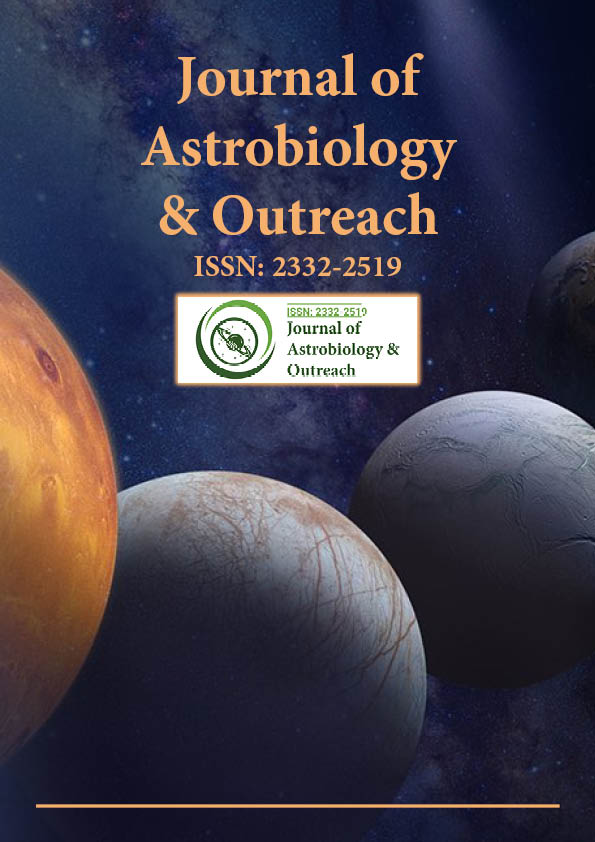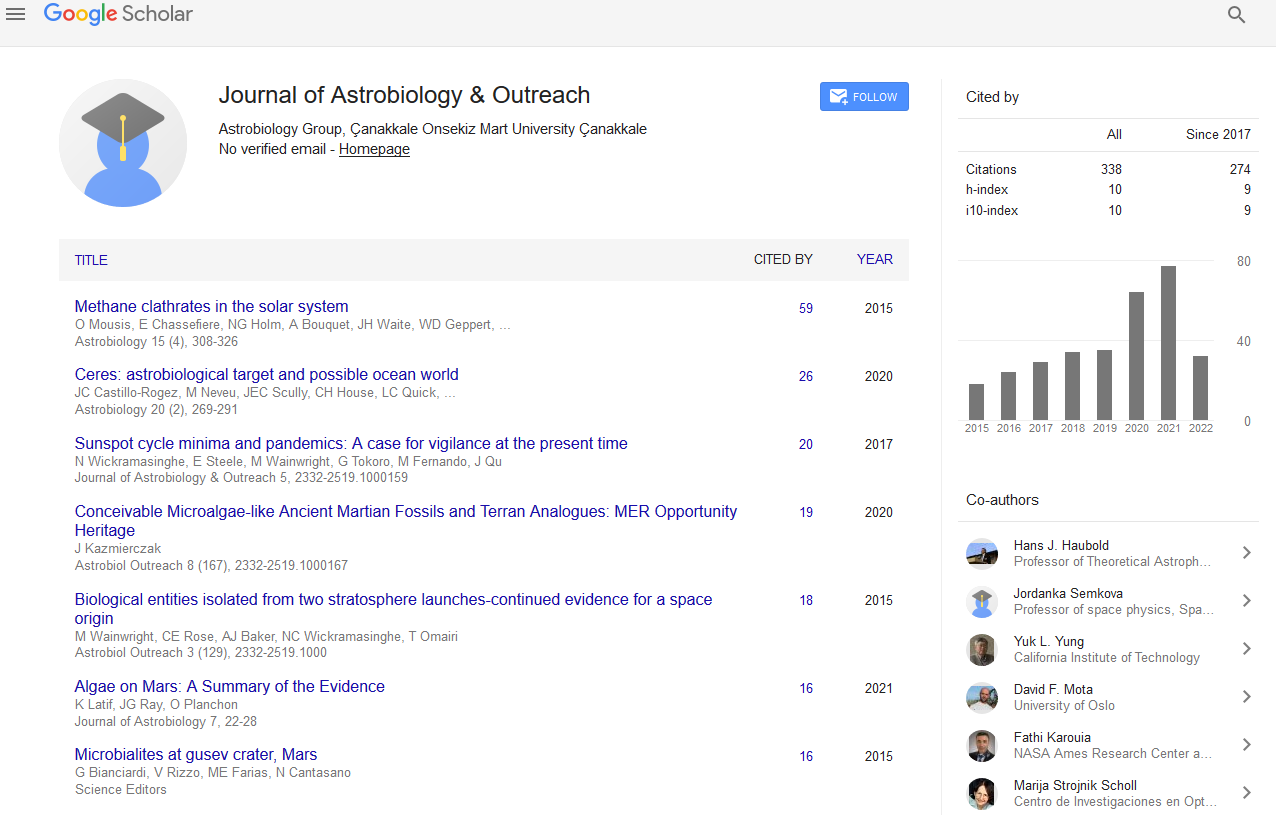Indexed In
- Open J Gate
- Academic Keys
- JournalTOCs
- RefSeek
- Hamdard University
- EBSCO A-Z
- OCLC- WorldCat
- Google Scholar
Useful Links
Share This Page
Journal Flyer

Open Access Journals
- Agri and Aquaculture
- Biochemistry
- Bioinformatics & Systems Biology
- Business & Management
- Chemistry
- Clinical Sciences
- Engineering
- Food & Nutrition
- General Science
- Genetics & Molecular Biology
- Immunology & Microbiology
- Medical Sciences
- Neuroscience & Psychology
- Nursing & Health Care
- Pharmaceutical Sciences
Opinion Article - (2023) Volume 11, Issue 5
Beyond Carbon-Based Life: Exploring Alternative Biochemistries in Exobiology
Harry Jones*Received: 22-Aug-2023, Manuscript No. JAO-23-24779; Editor assigned: 25-Aug-2023, Pre QC No. JAO-23-24779(PQ); Reviewed: 08-Sep-2023, QC No. JAO-23-24779; Revised: 15-Sep-2023, Manuscript No. JAO-23-24779(R); Published: 25-Sep-2023, DOI: 10.35248/2332-2519.23.11.313
Description
For decades, the search for extraterrestrial life has been largely centered around the assumption that life elsewhere in the universe would share the same basic factor as life on Earth. Carbon, with its unparalleled ability to form complex organic molecules, has been a lead in this search. However, as our understanding of biochemistry expands, scientists are now considering the possibility of alternative biochemistries.
The prevalence of carbon-based life on Earth is a result of carbon's unique ability to form stable, diverse, and complex molecules. Carbon's versatile bonding properties allow it to create the complex molecular structures that serve as the foundation for all known life forms, from simple bacteria to complex multicellular organisms.
However, limiting the search for extraterrestrial life to carbonbased biochemistry might overlook potential forms of life that rely on alternative elements and molecular structures. As our understanding of extreme environments on Earth expands, scientists are increasingly open to the possibility that life may exist beyond the constraints of carbon-based chemistry.
Silicon, located just below carbon on the periodic table, shares some chemical similarities with carbon. In the search for alternative biochemistries, silicon has often been considered a potential candidate. While silicon-based compounds can be stable under certain conditions, the challenge lies in finding environments where silicon can support the complex structures and processes essential for life.
Boron, another element with chemical properties that resemble carbon, has been proposed as a potential alternative to carbonbased life. Boron-based molecules could exhibit unique biochemical characteristics, and their stability under various conditions makes them an interesting avenue for exploration in exobiology.
On Earth, life relies on water as a solvent for biochemical reactions. However, some scientists have proposed the idea of ammonia-based life, where liquid ammonia would serve as the medium for biological processes. Ammonia has different properties than water and remains liquid at much lower temperatures, expanding the potential habitable zones for life.
While carbon-based life on Earth predominantly relies on oxygen for respiration, sulfur-based life could use sulfur compounds instead. Deep-sea hydrothermal vents on Earth, where life thrives in the absence of sunlight, provide a glimpse into environments where sulfur-based organisms might exist.
Phosphorus is an essential element for life on Earth, particularly in the structure of DNA and RNA. However, some researchers have considered the possibility of life forms using alternatives to phosphorus, such as arsenic. Arsenic-based biochemistry remains speculative but challenges the traditional view of life's elemental requirements.
The exploration of alternative biochemistries comes with significant challenges and considerations. One major hurdle is the need to identify suitable environments that could support the stability and complexity of alternative molecules. Additionally, the search for extraterrestrial life often relies on our understanding of life as we know it, making it challenging to recognize and interpret unfamiliar biochemical processes.
Environmental conditions, such as temperature, pressure, and the availability of solvents, play important roles in determining the feasibility of alternative biochemistries. Identifying celestial bodies with conditions conducive to these alternative forms of life remains a complex task, requiring a comprehensive understanding of planetary and atmospheric dynamics.
As our technology advances and our ability to study distant celestial bodies improves, the search for alternative biochemistries gains momentum. Missions to explore the icy moons of Jupiter and Saturn, such as Europa and Enceladus, provide opportunities to investigate environments where alternative life forms might exist.
Astrobiology missions, like the Mars rovers and upcoming missions to Europa, aim to explore the potential habitability of other celestial bodies within our solar system. Beyond our solar system, advancements in telescope technology, including the James Webb Space Telescope, potential to enhance our ability to analyze the atmospheres of exoplanets for potential biosignatures, even those associated with alternative biochemistries.
The exploration of alternative biochemistries in exobiology represents a change of opinion in our understanding of the conditions required for life in the cosmos. While carbon-based life has proven successful on Earth, the vastness of the universe presents an opportunity for diversity in the forms life could take. As scientists push the boundaries of our knowledge, the search for extraterrestrial life extends beyond the limitations of our own biochemistry, opening the door to the possibility of discovering truly alien forms of life. Whether its silicon, boron, ammonia, sulfur, or other elements and compounds, the search to understand the potential diversity of life in the universe continues to captivate the imagination of scientists and enthusiasts alike.
Citation: Jones H (2023) Beyond Carbon-Based Life: Exploring Alternative Biochemistries in Exobiology. J Astrobiol Outreach. 11:313.
Copyright: © 2023 Jones H. This is an open-access article distributed under the terms of the Creative Commons Attribution License, which permits unrestricted use, distribution, and reproduction in any medium, provided the original author and source are credited.

